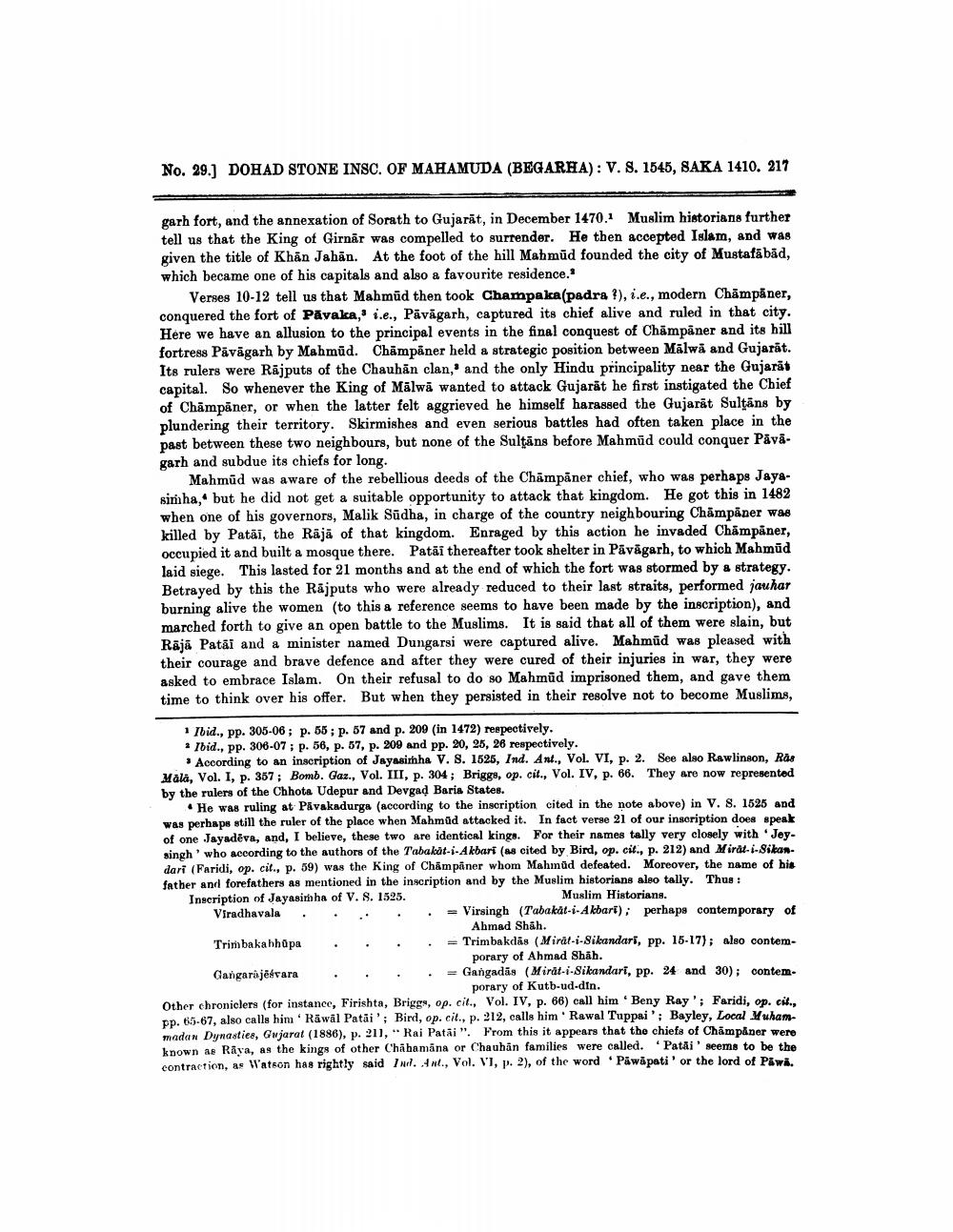________________
No. 29.) DOHAD STONE INSC. OF MAHAMUDA (BEG ARHA): V. S. 1545, SAKA 1410. 217
garh fort, and the annexation of Sorath to Gujarat, in December 1470.1 Muslim historians further tell us that the King of Girnar was compelled to surrender. He then accepted Islam, and was given the title of Khan Jahān. At the foot of the hill Mahmud founded the city of Mustafābäd, which became one of his capitals and also a favourite residence."
Verses 10-12 tell us that Mahmud then took Champaka(padra ?), i.e., modern Chămpaner, conquered the fort of Pāvaka, i.e., Pāvägarh, captured its chief alive and ruled in that city. Here we have an allusion to the principal events in the final conquest of Champāner and its hill fortress Pāvāgarh by Mahmūd. Champāner held a strategic position between Malwi and Gujarat. Its rulers were Rājputs of the Chauhān clan,' and the only Hindu principality near the Gujarat capital. So whenever the King of Malwā wanted to attack Gujarāt he first instigated the Chief of Chămpāner, or when the latter felt aggrieved he himself harassed the Gujarat Sultans by plundering their territory. Skirmishes and even serious battles had often taken place in the past between these two neighbours, but none of the Sultans before Mahmūd could conquer Pāvā. garh and subdue its chiefs for long.
Mahmud was aware of the rebellious deeds of the Champāner chief, who was perhaps Jayasimha, but he did not get a suitable opportunity to attack that kingdom. He got this in 1482 when one of his governors, Malik Sūdha, in charge of the country neighbouring Chămpaner was killed by Patāi, the Rājā of that kingdom. Enraged by this action he invaded Champåner, occupied it and built a mosque there. Patãi thereafter took shelter in Påvägarh, to which Mahmud laid siege. This lasted for 21 months and at the end of which the fort was stormed by & strategy. Betrayed by this the Rajputs who were already reduced to their last straits, performed jauhar burning alive the women (to this a reference seems to have been made by the inscription), and marched forth to give an open battle to the Muslims. It is said that all of them were slain, but Rājā Patāi and a minister named Dungarsi were captured alive. Mahmūd was pleased with their courage and brave defence and after they were cured of their injuries in war, they were asked to embrace Islam. On their refusal to do so Mahmud imprisoned them, and gave them time to think over his offer. But when they persisted in their resolve not to become Muslims,
1 Ibid., pp. 305-06; p. 55; p. 57 and p. 209 in 1472) respectively. * Ibid., pp. 306-07 : p. 56, p. 57, p. 209 and pp. 20, 25, 26 respectively.
• According to an inscription of Jayasimha V. S. 1525, Ind. Ant., Vol. VI, p. 2. See also Rawlinson, Ras Mala, Vol. I, p. 357; Bomb. Gaz., Vol. III, p. 304; Briggs, op. cit., Vol. IV, p. 66. They are now represented by the rulers of the Chhota Udepur and Devgad Baris States.
• He was ruling at Pāvakadurga (according to the inscription cited in the note above) in V. S. 1525 and was perhaps still the ruler of the place when Mahmud attacked it. In fact verse 21 of our inscription does speak of one Jayadeva, and, I believe, these two are identical kings. For their names tally very closely with Jeysingh' who according to the authors of the Tabakåt-i-Akbari (as cited by Bird, op. cit., p. 212) and Miral-i-Sikandari (Faridi, op. cit., p. 59) was the King of Champāner whom Mahmûd defeated. Moreover, the name of his father and forefathers as mentioned in the inscription and by the Muslim historians aloo tally. Thus: Inscription of Jayasimha of V. S. 1525.
Muslim Historians. : - Virsingh (Tabakat-i-Akbari); perhape contemporary of
Ahmad Shah. Trimbaka bhupa . . . . = Trimbakdās (Mirat-i-Sikandars, pp. 15-17); also contem
porary of Ahmad Shāh. Gangarājēkvara . . . . = Gangadās (Mirat-i-Sikandari, pp. 24 and 30); contem.
porary of Kutb-ud-din. Other chroniclers (for instance, Firishta, Briggs, op. cit., Vol. IV, p. 66) call him 'Beny Ray'; Faridi, op. cit., PP. 65-67, also calls him Råwål Patāi'; Bird, op. cit., p. 212, calls him Rawal Tuppai'; Bayley, Local Wuhanmadan Dynasties, Gujarat (1896), p. 211, TM Rai Patăi". From this it appears that the chiefs of Champåner were known as Raya, as the kings of other Chahamana or Chauhan families were called 'Patăi' seems to be the contraction, as Watson has rightly said Inl.nl., Vol. VI, p. 2), of the word 'Pāwāpati'or the lord of Pawi.




